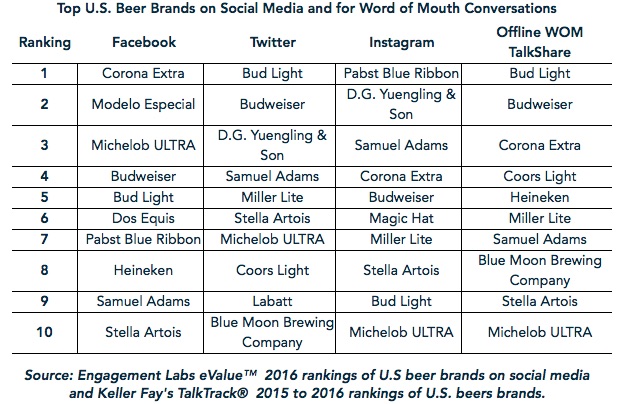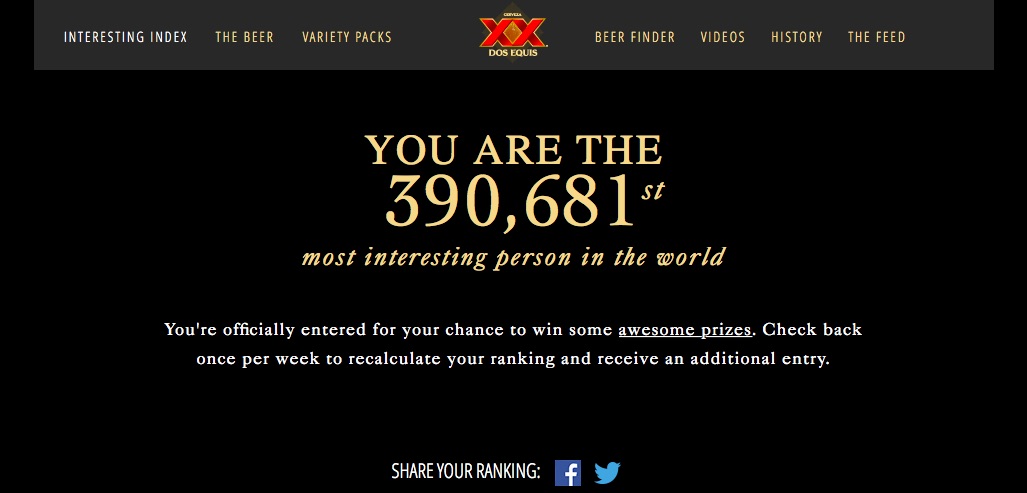Brands
3 Beer Brands Brewing Great Social Media Campaigns
Every Tuesday, the two-person social media team at Colorado-based New Belgium Brewing Company sits down to review last week’s social media analytics and determine what to put on the calendar for the week to come.
They cover a lot of ground. New content might take the form of a beer cocktail recipe on the blog, a Twitter poll, an animated GIF, or a video highlighting its 25th anniversary “Collabeeration pack.” Everything is created in-house, and the duo has begun creating exclusive “beer geek” content on emerging platforms like Snapchat, Periscope, and Facebook Live.
If you’re a beer brand, you can get consumer attention in a couple of different ways. One option could be a stunt like temporarily change your name to “America,” as Anheuser-Busch is doing with Budweiser this summer. Or you can brew up a social media campaign with a flavor that’s as unique as your beer.
The bottom line: If beer brands hope to engage consumers, they have to adopt a social media strategy that ensures they’ll stand out. The beer business, after all, is ridiculously competitive. According to The Beer Institute, the industry contributed $252 billion to the U.S. economy last year. And there are over 2,500 different breweries in the U.S. alone, each with multiple brews.
There’s no one-size-fits-all formula for success on social media for beer brands, but look closely and you’ll see a pattern. Social media measurement company Engagement Labs recently evaluated and ranked U.S. beer brands based on their social media presence. The company measured engagement, impact, and responsiveness across Facebook, Twitter, and Instagram from January to April of this year. The researchers found that successful beer brands are relevant, transparent, and know how to play to each platform’s individual strengths.

“Using the same strategy across channels doesn’t work,” said Bryan Segal, CEO of Engagement Labs. “You have to spend a lot of time and effort to create socially-enabled content that creates shareability and talkability, and really drives one-to-one conversations.”
Across the beer landscape, competition and a new digital ecosystem is spurning innovative campaigns. Breweries of all sizes, from New Belgium to Dos Equis to microbrewery Great Lakes Brewing Company, are taking idiosyncratic approaches to their social media content—and finding new ways to stand out from the pack.
New Belgium
For Segal, One of the biggest takeaways from the Engagement Labs study was that good social media content isn’t all product-centric.
“It’s also about corporate responsibility and using images and content to attach to a customer base,” he said. “It offers a very different type of experience for users and a way for brands to drive engagement and loyalty while bringing a face to the bottle.”
New Belgium—which was ranked as a Genius brand by business intelligence firm L2, in part for its success on social—uses its social media channels to lift the curtain on the company’s daily operations.
“We look at what’s going on with the brand right now and how we can take people behind the scenes,” said Kevin Darst, digital manager at New Belgium.
On Periscope, the brand has shown consumers its office expansion and chatted with brewers about its new tangerine IPA, Citradelic. That stream was saved to YouTube for those who missed it on Periscope and Twitter, and was promoted on the New Belgium blog. The brand’s most successful Periscope stream to date received about 800 live views.
https://youtube.com/watch?v=59w4u97mhHc
New Belgium’s Snapchat content is likewise aimed at craft-beer drinkers who value seeing the brewers and blenders up close. Viewers can experience a walk-through of the tasting room, check out the canning line, and ask questions about the brewing process.
“It’s less about new products and more about brewery life,” Darst said. “Working here is sort of like working in Willy Wonka’s chocolate factory. The vibe is really awesome, and we try to capture that in those snaps.” In April, snaps for National Beer Day were featured on the main Snapchat Stories page and generated more than 10 million views.
This strategy also helps the brand get around the thorny issue of underage drinking. The Beer Institute’s advertising regulations, which are occasionally reviewed by the FTC, require that marketing only take place on platforms where more than 71.6 percent of the audience are adults of the legal drinking age.
Since New Belgium’s Snapchat and Periscope content focuses on brewery life rather than product promotion, it’s more likely to appeal to long-time customers and fans—and less likely to be censored.
However, Darst acknowledges that Snapchat has its challenges. The platform doesn’t let you gate content for certain ages the way that Facebook and Twitter can, and brands don’t have the space to tell consumers they must be over 21 to follow.
“We try to be as responsible as we can there,” Darst said, “but it’s difficult.”
New Belgium’s first Facebook Live broadcast took place in May, when the brand cut the ribbon on its newly expanded tasting room and outdoor space. “It did extremely well,” Darst said. “Live gives you the broadcast opportunity of Periscope but with the scale of Facebook, and we get much better reach than we do with our organic posts. Facebook treats Live content differently.”
The four-minute video received upwards of 25,000 views—five to 10 times more than the brand’s average Facebook post.
“We will definitely be doing more of these,” Darst said.
Dos Equis
You could argue that nobody brings a face to the bottle like Dos Equis, beer of choice of The Most Interesting Man in the World. The brand has been using social media since 2008, and its debonair mascot, introduced nine years ago, is a big part of that.
“Fans love a strong voice—it’s the most identifiable aspect for any brand,” said Rachel Korenstein, social strategist with Havas Worldwide New York, which manages all digital and offline creative and strategy for the brand. “We try to create a three-hundred-and-sixty-degree world on social, and use each platform to our advantage to help further the story people are seeing on TV.”
The brand is currently focusing its efforts on Facebook, Instagram, and Twitter, and its approach to social marketing is twofold: tell a dynamic story and go heavy on visuals. Nearly all posts—created by a four-person social team with input on paid promotion from the media department—have a visual component and often also integrate video. To optimize for Facebook, where videos auto-play without sound, Dos Equis has been using closed captioning for calls to action.
This year, Dos Equis celebrated Cinco de Mayo by bidding “adios amigo” to The Most Interesting Man, who will soon be replaced with a younger spokesperson. The brand sent The Most Interesting Man on a one-way trip to Mars in a TV spot that, with the help of the #adiosamigo hashtag, extends to the web.
On Twitter, the campaign led to extended conversations with fans, even inciting some of them to adopt the brand voice in their replies.
“With #adiosamigo this year, we had content with mass reach, but the deeper level of engagement we want comes from one on one interaction,” Korenstein said.

At the beginning of June, Dos Equis launched the Interesting Index, an interactive tool housed at DosEquis.com that ranks consumers based on data pulled from their Facebook page. The Index is currently being promoted with two new TV spots featuring sports personality Erin Andrews and character actor Luis Guzmán.

Great Lakes Brewing Company
When Cleveland-based craft brewery Great Lakes Brewing Company underwent a brand refresh last summer, social media became the go-to tool to promote its new look.
“Great Lakes is twenty-seven years old—eons in the craft beer world—and its heritage is a big part of its social content,” said Mark McKenzie, associate creative director with Brokaw, the brand’s long-time advertising agency.
“Regionally—and especially locally—this is a beloved cult brand with a really loyal following,” added Brokaw’s creative director Steve McKeown. “Branding is a sensitive area, and using videos on social media allowed us to walk fans through the changes in a fun and approachable way and let them know we respect the brand’s story.”
Brokaw worked with sister company Favorite Brother to produce a series of social videos that explained the company’s origins and the evolution of the brand’s labeling, which were posted on Vimeo and Facebook. “We took an unpaid approach with the videos, sharing them with our followers as a fun complement to a larger digital campaign that successfully increased site traffic and increased social engagement,” a spokesperson for Great Lakes Brewing said.
For Great Lakes Brewing, Facebook and Instagram are the social sites with the most value, the former for its targeting capabilities, and the latter to visually communicate brand imagery to consumers.
Twitter is used to gather “valuable feedback on flavor and quality.” As social media is handled both by the brand and its agency, and regional sales people also post on the brand’s behalf, Brokaw developed a social media playbook for use by all. “That playbook is essential for giving everyone direction and ensuring consistency,” McKenzie said.
Beyond staying consistent, the lesson for beer brands is this: Social media content must be exclusive, distinctive, and have substance. In this industry, there’s no room for bad foam.
Get better at your job right now.
Read our monthly newsletter to master content marketing. It’s made for marketers, creators, and everyone in between.




